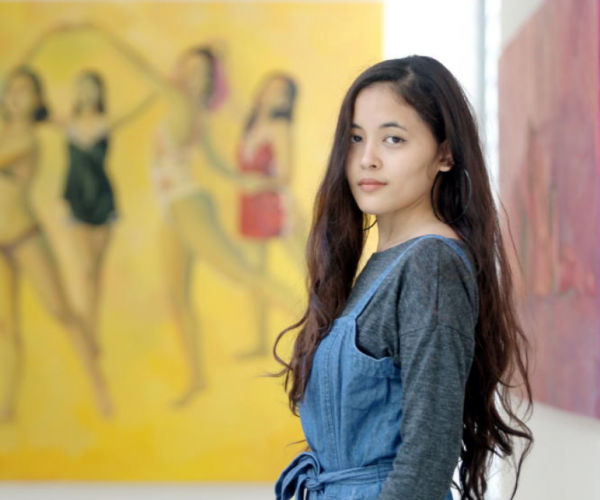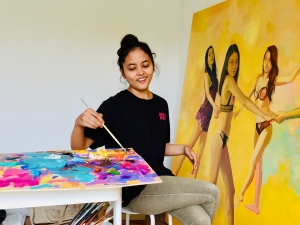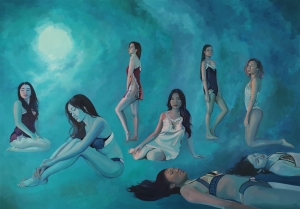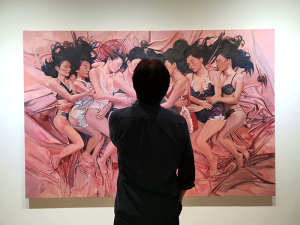
I had the pleasure to meet Sofia Haron through a mutual friend, and it is always a humbling experience to be able to connect with an artist; a creator. The intensity of the painter’s eyes was magnified from the flashing fluorescent lights coming from one of an outdoor installation in Kuala Lumpur’s hippest hangout spot, APW. I could sense that her energy is a direct reflection and byproduct of her dreamy works.
It was definitely an intense encounter.
To be frank, at first, I was intimidated by the energy I received from the petite painter. (Not wanting to sound cliche) However, Sofia has a natural gift to make one feel at ease. So after exchanging a few words to each other, I got more comfortable but was surprised to know how selective she is when it comes to opening up about her past experiences, not because she is shy or because she is deceptive, but it’s a type of silence that was accompanied by melancholy. The hardship she has experienced is now a medium for her to channel through pictorial art. Not many would sense that because the pain has always been masked by her stylistics, but most empaths could feel the pain from the first glance of many of her creations.
“The burdens can be seen as uplifting if an individual can see the beauty behind the pain.”
Not that she is constantly in pain, but she has gone through a lot while growing up. “I observe a lot,” She stared profoundly into my eyes, “some people might think I don’t have an opinion, but I simply observe to understand their point of view. It’s like, I’m observing with my third eye.”

Quoting Sarah NH Vogeler, “Writers are tenacious creatures, we set out to procure a story, and even if it means holding someone hostage, we would do it happily and guilt-free.” But here I am, ironically being held hostage in Sofia’s studio for more than 48 hours. I’m in her world to absorb everything about her and her paintings like I was a sponge. Time was spent mostly for napping and eating, all the while I pay close attention to her paint her version of soft and dreamy classical art references via her philosophical aesthetics, allowing her to reminisce about her past.
Sofia Haron never fails to surprise me with her eccentricity. Randomness was just in her nature, the playlist would be on shuffle from trap songs to classical waltz to pop-punk to Malay “rock kapak” (a genre of Malaysian rock) and we would be travelling through different genres within 30 minutes, which is completely chaotic. But Sofia still remains graceful and kind even with all the disorder that was happening around us.
Sofia Haron’s first solo is made up of 10 oil paintings portraying Eve’s role and society’s perception of her in this day and age of the 21st Century. Each painting depicts women in their natural order in this world – chaotic and even passive for most. This series reflects this beautiful attribute to life, as so it is an embedded trait of femininity itself. Celebrating womanhood with all its twisted ways, the pieces created by Sofia Haron for her first solo exhibition invites you to question and observe the relationship between females and the chaos that comes with it.
“Sisterhood is still being celebrated within complacent chaos and love is still being stretched from the vaginal spread.”
Elements of temptation for each painting, however cleverly disguised by her dreamy aesthetic, the audience is being asked to look past their lingerie armour and see how deeply (inter)connected the subjects are between each other through space or the lack of. This is evident in “Vaginal Spread” and “Descension” whereby the painter plays elegantly with the two pieces juxtaposing depth and the size of the piece(s) itself.
Suma Orientalis, Sofia Haron, Eve

Sofia manages to manipulate the audiences’ surrounding with the use of colour in her paintings, giving off an extreme sense of altered consciousness to any viewer. Choosing what some might describe as soft pastel hues, the narration of the content transports one to her version of the Garden of Eden.
There is a lot to be said about Sofia Haron’s paintings that reflects grace within chaos, ultimately in “Kawan Tapi Lawan” is a piece that is not just about the female form but also the relationship between females and their egos. Sofia believes that women are beautiful beings created to spread love and chaos all at the same time, this is evident with all of the downfalls she went through and most of them were with her closest female peers and sisters.
“It’s a connection that will always be there, it’s just an interaction between one human being with another. Whereby the interaction had to happen, to learn and reflect upon oneself, on what should (have been) a balanced relationship. It’s to appreciate the differences amongst one another. It’s to comprehend that love is eternal, though it might be masked with insecurities, and differences of one’s principles and belief.”
Sofia expresses the curiosity behind human being’s deceptive nature in “Venus.” The painter intends to question one’s wisdom and knowledge about the divine as being absolute or mutable by referencing Michelangelo’s The Creation of Adam.
“Lilith”, the counterpart to Venus, is depicted with a cigarette between her lips, probably the coolest girl of the bunch. Lilith’s gaze, nonchalant and unconcerned leaves you wondering what you’ve done wrong and what you could have gotten away with it.
With “Guardian,” Sofia questions the symbolism of animals and their relationship with the subject matters in the paintings by associating the animal with human personalities which are usually mislabelled or socially defined as just beings that are one dimensional when everything is ultimately multifaceted.

“Flower of Life” and “Summer” depicts the females convoluted together in different ways, whereby strength is in the number and challenges you to see beyond your internal struggles to move forward with pure love and passion.
For “The Other Women”, Sofia paints issues of insecurities and internalises misogyny due to the conformity of being the “ideal female” which is deeply rooted within society itself.
The women in “Amethyst” symbolise energy and wisdom, hence the painter exercises confident brush strokes, with a “devil-may-care” attitude towards the subject. She is the most inspiring amongst all the daughters of Eve.
Sofia selected all eight Malaysian models as her references for her first solo, that came from different cultures and backgrounds. She stretches even further with her first solo with the help of Sakiyurai, Amani and Amir Johari. Their energies and their own technique at capturing the “feminine ideal beauty” have helped shape the aesthetic for her inspiration, from beginning to the end. The muse, Eve.
Eve is being presented to us as Adam’s partner in all of the scriptures known to mainstream media, his soulmate, his partner. Same is as so within each and every one of us, friends and family alike, connected on a soul level within each other. It is a depiction of relationships between females and even with destruction, there is softness and gentleness.
what society has deemed females should look and feel beautiful soft demure creatures.
All in all, Sofia Haron’s first solo celebrates the union of females, being daughters of Eve, Venus, Lilith, Kuan Yin, Kali, all other Female Ascended Masters, Goddesses and the Other Women. It is difficult to not get moved or empowered when you are being surrounded by Sofia’s paintings.
sitis
Feature Writer
In Radar
